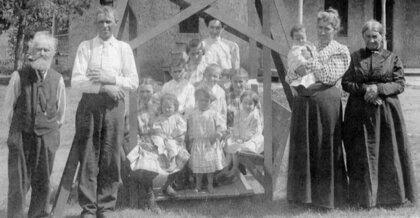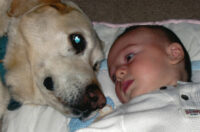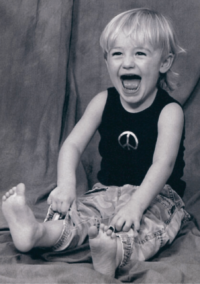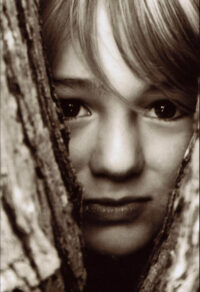Chapter 18: • Minnesota, The Clemens Farm ~ My grandparents were known for attending funerals. Relatives, close friends, acquaintances, people they barely knew—it didn’t matter—Barbara and Mathew went to all of them. It was their social center. If anyone wanted to visit them and a nearby funeral was happening, they knew Grandpa and Grandma would be in attendance. Friends and family from afar often went to the funerals just to see them. The church was their other social center and the family attended Mass every Sunday at St. John’s Catholic Church. The Ten Commandments, common sense, and good judgment directed their lives. All the surrounding farms and townspeople in the area were Catholic, and all went to St. John’s. Only two families were Lutheran, and they rented.

My grandfather was a year old when his family moved from Mazeppa in 1875 into the new farmhouse just west of the outskirts of Rochester. He grew up in this house, and when he married, their children were all born and raised in it too. It was on a 210-acre dairy farm that in the first white of winter was a Norman Rockwell picture of snow-covered paradise. Theirs was the first farm west of the outskirts of the city of Rochester in Olmsted County. The rolling prairie land was purchased in the early 1870s by my great-grandfather, Mathew Clemens. In 1874, he and one of his three brothers, Peter, both stonemasons from Luxembourg, built the original three-story, nine-bedroom stone house. It was four rooms square, built by rocks collected from nearby land that needed to be cleared. The stones layered like a jigsaw puzzle, stuccoed and pebble-dashed on the outside and plastered smooth on the inside, the walls thick enough for window seats. The 18-inch thick walls made it a deep freeze in the wintry Minnesota weather, so a huge wood-burning stove heated the entire house day and night.
In the late afternoon of August 21, 1883, a tornado rolling upward to fantastic heights ripped through the area and ransacked rural Olmsted County. The funnel-shaped blackness demolished much of Rochester and the countryside around it. Striking the Clemens’ house, it tore off the entire gabled roof and part of the third floor, leaving the rest of the solid stone building standing. When the devastation was over and the town and farms began to rebuild, Mathew Clemens, Sr., my great-grandfather—who had suffered a broken leg in the tornado—removed the remainder of the third floor and re-roofed it to a two-story, five-bedroom structure. My grandfather was nine at the time.
Four generations of Clemens grew up within those stone walls, surrounded by cows, company, and Catholicism. You weren’t considered a good Catholic unless you had a child at least every other year. All the Clemens babies were baptized in the same white lace-collared dress made by their Aunt Lena Nigon.
In the spring of 1898 my grandparents, Mathew Sylvester Clemens, the youngest of his family, and Barbara Nigon, the oldest of hers, were married in St. John’s Church in Rochester. Blessed with 10 living children, they raised crops, cows, and kids on the family farm for the next forty-some years. The farm was taken care of by Grandpa and his father until 1910, then my great-grandparents moved into Rochester to live with their older son Peter until their deaths several years later. My grandparents purchased the farm from them, making yearly payments until the debt was paid.
To be continued…
Catherine Sevenau is a writer, humorist, and storyteller living in Sonoma, California. The stories in this series are excerpts from her book, Through Any Given Door, a Family Memoir, available as a series at Sevenau.com. A longtime Realtor and Owner/Broker at CENTURY 21 Wine Country. Csevenau@earthlink.net






Be First to Comment